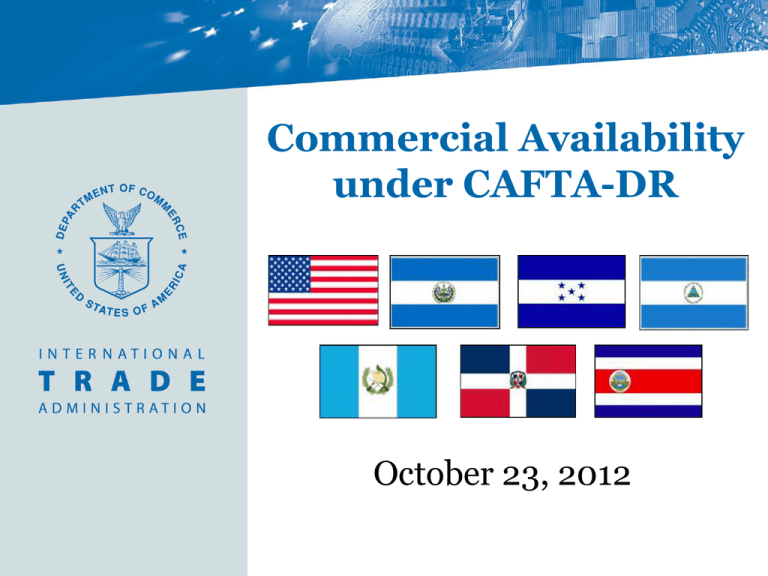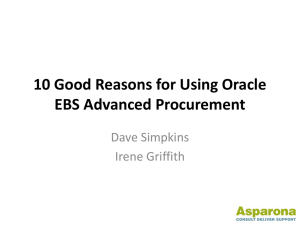Commercial Availability Under CAFTA-DR
advertisement

Commercial Availability under CAFTA-DR October 23, 2012 Presentation Overview • CAFTA-DR: Sourcing Advantages for Importers and Textile Producers • The CAFTA-DR Short Supply Process • Product Descriptions • Due Diligence • Effect of Technical Fixes on Short Supply 2 Level of Trade under DR-CAFTA Short Supply ($US millions) DR-CAFTA Region 2008 2009 2010 2011 Total apparel imports $7,677 $6,221 $7,084 $7,927 $188 $187 $249 $294 2.4% 3.0% 3.5% 3.7% Apparel using short supply yarn/fabric Percent of imports 3 Sourcing Decisions and Short Supply • Western Hemisphere trade preferences provide competitive advantages for sourcing in the hemisphere. • Brands, retailers and importers can take advantage not only of proximity to market, but lower costs achieved through duty-free treatment. • Textile producers looking for new opportunities may be able to find potential new business and build on current capabilities and existing relationships. • Short supply provisions can offer “out of the box” opportunities throughout the supply chain. 4 The DR-CAFTA Short Supply List: Annex 3.25 There are 141 products: 3 fibers, 14 yarns, 124 fabrics There have been: • 83 Requests accepted for review • 70 Requests to Add approved • 1 Request to Remove approved 5 The CAFTA-DR Short Supply Process • After receiving a request for a particular product, CITA determines whether that product is commercially available. • But CITA does not contact potential suppliers to investigate whether the product is available. • CITA is the adjudicating authority. CITA does not collect information – it only reviews information submitted on the record. • Interested entities submit evidence to CITA to support their claims as to the commercial availability of the subject product, and CITA makes its determination based ONLY on that evidence. 6 The DR-CAFTA Short Supply Process: “Due Diligence” is CRITICAL! • Because CITA does not collect information, interested entities must provide evidence based on their “due diligence.” • For Requestors, due diligence is a reasonable effort to source the product from DR-CAFTA suppliers. • For potential suppliers, due diligence is the offer to supply the product, and a demonstration that they can produce it or one that is substitutable. 7 Requestors: How do you start? If you think that a product isn’t available in the region, you must compile evidence to support your claim. • Describe the product: – Reasonable specifications (industry standards)? – Reasonable deadline and quantities? – Is there a substitutable product? • Identify potential suppliers, and contact them to confirm whether they can or cannot supply the product. • Collect documents to support your claim. 8 Reasonable Product Description • Don’t make it too broad. • Make sure you include relevant specifications that would affect a supplier’s capability to produce the product. • If you include performance requirements, they must have measurable criteria. Identify any relevant testing methods. • Disclose any requirements for deadlines and quantities. • Include explanations for any specifications or requirements that might be outside industry standards. 9 What are Relevant Specifications? • “Relevant Specifications” are those that will determine whether a potential supplier has the capability to produce the product. • Not necessary to provide all specifications that would be provided to a supplier (i.e. mill specifications). • Depending on the product, the relevant specifications may be yarn sizes, fiber content, weave types, and/or finishing processes. • If a particular specification, e.g. width, is not going to be a determining factor in whether a supplier is capable of producing the good, then you don’t have to include it in your product description. • But be prepared that if a supplier can supply the product, it can provide a product of any width. 10 Don’t forget TOLERANCES! • Some physical parameters can change after construction. Dyes and other finishing processes can affect yarn size, thread count, colorization, and weight. • Even though you provide specifications based on construction parameters, take into account how post-construction processes can affect physical characteristics. • Customs tests the entered apparel, NOT the fiber, yarn or fabric. If test results fall outside specifications, they will deny duty-free treatment. • CITA CANNOT MAKE ANY CHANGES to a product description once its been submitted by a requestor. Expansion of specifications must be made in a new Request. 11 Downstream Products and Finishing • CITA will not accept a Request if it finds that it is only an “upstream input” and not the “downstream” product that is unavailable. • For example, if the inquiry is for a fabric that calls for a specific yarn, if a supplier can make the fabric but the yarn isn’t available in the CAFTA region, a supplier will say so in its response to the requestor. • Confirm with the supplier, but be prepared to modify your Request to ask for the upstream input. • In the same way, CITA also does not accept Requests where the only aspect of the product that’s “unavailable” is a finishing process. 12 Due Diligence Inquiries: What must the Potential Supplier provide? • An offer to supply the specified product or one substitutable. • Detailed information on its production capacity and capability, and, if applicable, information about the substitutable product. • Must identify all sub-contractors, with information about the contractor’s capability. • While you may ask for certain information and/or a sample, suppliers are NOT required to provide business proprietary information, or provide samples. 13 Due Diligence Inquiries: What if I don’t think the Supplier is capable? If you don’t think a supplier has demonstrated its ability to supply the product as specified, or one that’s substitutable, be sure to: • Tell the supplier why you don’t think they’re capable, or why the product they offer is not substitutable. • Give the supplier an opportunity to respond, and to provide information that supports their claim. • Address the supplier’s arguments, and answer all questions. 14 Due Diligence Inquiries: What Doesn’t Matter • CITA does NOT consider whether the product is available outside the region at a lower price. As long as a potential supplier can demonstrate that it can produce the subject product or one substitutable, price is irrelevant. • As long as a supplier can meet all physical specifications included in a description, CITA does not consider a customer’s preference or other non-measureable criteria as reasonable requirements. • Issues regarding price, financing and means of delivery are considered terms of sale, and are not relevant. 15 Suppliers: Responding to a New Short Supply Request When you are notified by CITA that there is a new Request, confirm the following information: If you were contacted by the requestor prior to filing, • Is the product description the same you received in the inquiry? • Is the requestor’s summary of due diligence on your communications accurate? If you were not contacted by the requestor prior to filing, • Are the requestor’s statements about the product’s specifications and substitutability reasonable? • Determine if you wish to submit a Response with an Offer to Supply. 16 Suppliers: How to submit a Response with an Offer to Supply • Go over all the arguments and evidence in the Request. • If you think the Request contains inaccurate information, give an explanation in your Response. • MORE THAN ONE SUPPLIER can be included in Response. But all suppliers must provide information about their capacity and capability. • Always provide documentation to support your claim. • Be prepared – many times, the requestor will submit a Rebuttal. • If CITA calls for a public meeting, be prepared to address all the requestor’s claims. This is your LAST opportunity to demonstrate you can supply the product. 17 Requests to Remove or Restrict: Overview of the DR-CAFTA Process • A DR-CAFTA supplier may submit a Request to Remove certain products from Annex 3.25, or Restrict the Quantity that may be sourced outside the DR-CAFTA region. • Some products (#1-43) may not be removed – they were negotiated as part of the DR-CAFTA. All other products may be removed or restricted. • In its Request, the supplier must demonstrate that it can produce the specified product or one that is substitutable, and provide detailed information to support its claim. • The supplier must meet the same requirements CITA has for a Response with an Offer to Supply. • However, the supplier is NOT required to contact the original requestor or any other potential interested entity before it files its Request. 18 Requests to Remove or Restrict: Opportunities for Suppliers • Suppliers can review products on Annex 3.25 to determine if they can supply the product, exactly as described, or one that’s substitutable. • A supplier (or a combination of suppliers) must be able to produce the entire range of specifications included in the product’s description. • A supplier must provide the quantity of the product it can produce in a timely manner. 19 Requests to Remove or Restrict: Response by an Interested Entity • Any interested entity (e.g. a foreign supplier, a U.S. importer, a retailer), may object to the Request by submitting a Response by claiming that the supplier(s) are not capable of producing the subject product. • The Response must provide information supporting their argument, e.g. that the supplier’s equipment is not capable of producing the product as specified, or that the offer or a substituted product is not acceptable. • Be prepared - the supplier may submit a Rebuttal to the Response to address the responder’s claims. 20 Modifications to DR-CAFTA Rules of Origin for Textiles & Apparel On October 13th, the “CAFTA technical fixes” came into effect. Some of these modifications affect a product’s eligibility under the short supply provision: • Elastomeric content in a product in short supply does not have to be sourced in the region. • A product in short supply may now be used for narrow elastic fabrics, visible lining, thread, and pocketing. 21 ENFORCEMENT: Customs • While CITA determines whether a given product is or is not commercially available, it does not decide whether a specific entry is eligible for duty-free treatment. • Customs enforces the CAFTA rules of origin. If they determine that the apparel doesn’t qualify, they will disallow duty-free treatment. • Customs routinely tests apparel claiming preferential treatment under FTAs. Remember, if one specification lies outside the product description, it will not qualify. • CITA does NOT advise Customs on an entry’s eligibility. It can only confirm the product description. • If you have questions about a good’s eligibility, consider asking for an Advance Ruling. 22






